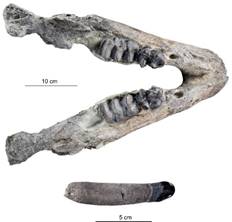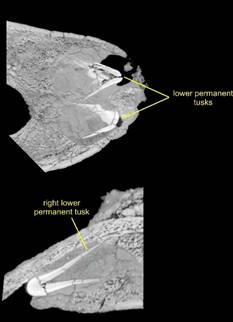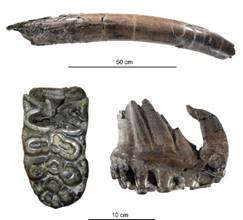News
20.09.2023
Proboscideans of the Hammerschmiede – contemporaries of the first upright ape
Research team of the University of Tübingen and the Senckenberg Centre for Human Evolution and Palaeoenvironment investigates fossils of eight early relatives of elephants from the fossil-rich site
Today, there exist only three elephant species, in Africa and Asia. Yet the diversity of proboscidean species and their distribution was significantly greater in the Earth's past. Researchers from the University of Tübingen and the Senckenberg Centre for Human Evolution and Palaeoenvironment, working at the Hammerschmiede site in southern Germany, have now described new fossils of early proboscidean species. The animals lived about 11.5 million years ago, at the same time as the first bipedal ape, Danuvius guggenmosi, who was found at the site in 2019. The team assigned the fossil remains of eight proboscidean individuals to two species. The findings have been published in the Journal of Mammalian Evolution.
Proboscideans are the largest land mammals we know today. Four of the animals from the Hammerschmiede belong to the now-extinct deinotheres (from the ancient Greek word "deinos" for terrible and "therion" for animal). This primitive proboscidean family had separated from the rest of the proboscideans 30 million years ago. Their characteristic features are backward-curved lower tusks, and the absence of upper tusks otherwise typical for elephants. These individuals, which are predominantly juveniles, were assigned to the species Deinotherium levius.
Nestled next to Danuvius: a baby deinothere
"Of particular importance is a discovery made in 2020, when a partial skeleton of a few-month-old Deinotherium baby was found for the first time," says Dr. George Konidaris, lead author of the new study. The juvenile, documented by 24 skeletal elements – including the lower jaw, ribs, pelvis, and tibia and fibula – was located in close proximity to a female Danuvius. The find is a stroke of luck for science, he explains, "Never before had a juvenile deinothere been discovered with both the permanent tusks and their precursors from the deciduous dentition still in place. This short phase in the life of proboscideans is rarely documented in fossils. The find therefore has great significance for a better understanding of the individual and life history of deinotheres."
In fact, the find from Hammerschmiede is only the third record worldwide of milk tusks in deinotheres. "The young animal's milk tusk was found right next to its lower jaw. Computer tomographic images of the jaw also already show the germs of the permanent tusks deep in the bone tissue," notes Hammerschmiede excavation manager Thomas Lechner. The lower jaw otherwise shows no other tooth germs, only deciduous premolars. From this, the researchers conclude that the permanent tusks erupted in deinotheres at a very early stage of development, while the deciduous dentition was still complete – this is similar in the elephants living today, their distant relatives. The tusks were therefore the first visible teeth in the permanent dentition of these animals.
Tetralophodon – the giant from the Hammerschmiede
The second species of proboscidean found at the Hammerschmiede is Tetralophodon longirostris. These hump-toothed proboscideans also differ from true elephants and mammoths in possessing tusks in both the upper and lower jaws. The most significant specimen of the four individuals from the Hammerschmiede is a partial skeleton of an adult bull, which was excavated more than 40 years ago by two private collectors, Sigulf Guggenmos and Manfred Schmid. "Based on the powerful tusks and the size and degree of wear of his molars, we suspect that it was a male between 37 and 48 years old. Its live weight was a good ten tons and its shoulder height about 3.5 meters," says George Konidaris.
The way the teeth were worn also tells researchers a lot about the diet of these proboscideans. While Tetralophodon probably preferred a mixed diet of leaves, twigs and grass, Deinotherium was purely a leaf-eater, says Panagiotis Kampouridis, PhD student and co-author of the study. These different feeding niches allowed the two large herbivores to coexist in the Hammerschmiede ecosystem.
Global warming twelve to eleven million years ago
The proboscideans from the Hammerschmiede are of outstanding importance for the chronological classification of the evolution of these proboscideans, says Professor Madelaine Böhme, head of the Hammerschmiede research project. The common occurrence of both species in Europe documents a short period of time between twelve and eleven million years ago which was characterized by relative dryness and very high temperatures, she explains.
Tetralophodon, which migrated into Europe, prevailed over more primitive hump-toothed proboscideans during this phase, Böhme adds. The increasingly humid climate after eleven million years led to tremendous change in the large mammals of Europe. Increasing forestation provided leaf-eating deinotheres with abundant food and enabled them to further increase their body size, leading to the evolution of the new species Deinotherium giganteum, according to Böhme.
The excavations at the Hammerschmiede were funded by the University of Tübingen, the Senckenberg Nature Research Society and the state of Bavaria.
Publication:
George E. Konidaris, Thomas Lechner, Panagiotis Kampouridis, Madelaine Böhme: Deinotherium levius and Tetralophodon longirostris (Proboscidea, Mammalia) from the Late Miocene hominid locality Hammerschmiede (Bavaria, Germany), and their biostratigraphic significance for the terrestrial faunas of the European Miocene. Journal of Mammalian Evolution, https://doi.org/10.1007/s10914-023-09683-3
Contact:
Dr. George E. Konidaris
University of Tübingen
Institute of Scientific Archaeology – Paleoanthropology and
Senckenberg Centre for Human Evolution and Palaeoenvironment
Phone +49 7071 29-76518
georgios.konidaris@uni-tuebingen.de
Professor Dr. Madelaine Böhme
University of Tübingen
Geosciences – Terrestrial Palaeoclimatology and
Senckenberg Centre for Human Evolution and Palaeoenvironment
Phone +49 7071 29-73191
m.boehme@ifg.uni-tuebingen.de
Contact for press:
Eberhard Karls Universität Tübingen
Public Relations Department
Dr. Karl Guido Rijkhoek
Director
Janna Eberhardt
Research Reporter
Phone +49 7071 29-76788
+49 7071 29-77853
Fax +49 7071 29-5566
karl.rijkhoekspam prevention@uni-tuebingen.de
janna.eberhardtspam prevention@uni-tuebingen.de
All press releases by the University of Tübingen
Senckenberg Nature Research Society
Press Office
Judith Jördens
Phone +49 69 7542 1434
judith.joerdens@senckenberg.de
pressestellespam prevention@senckenberg.de
www.senckenberg.de/presse



